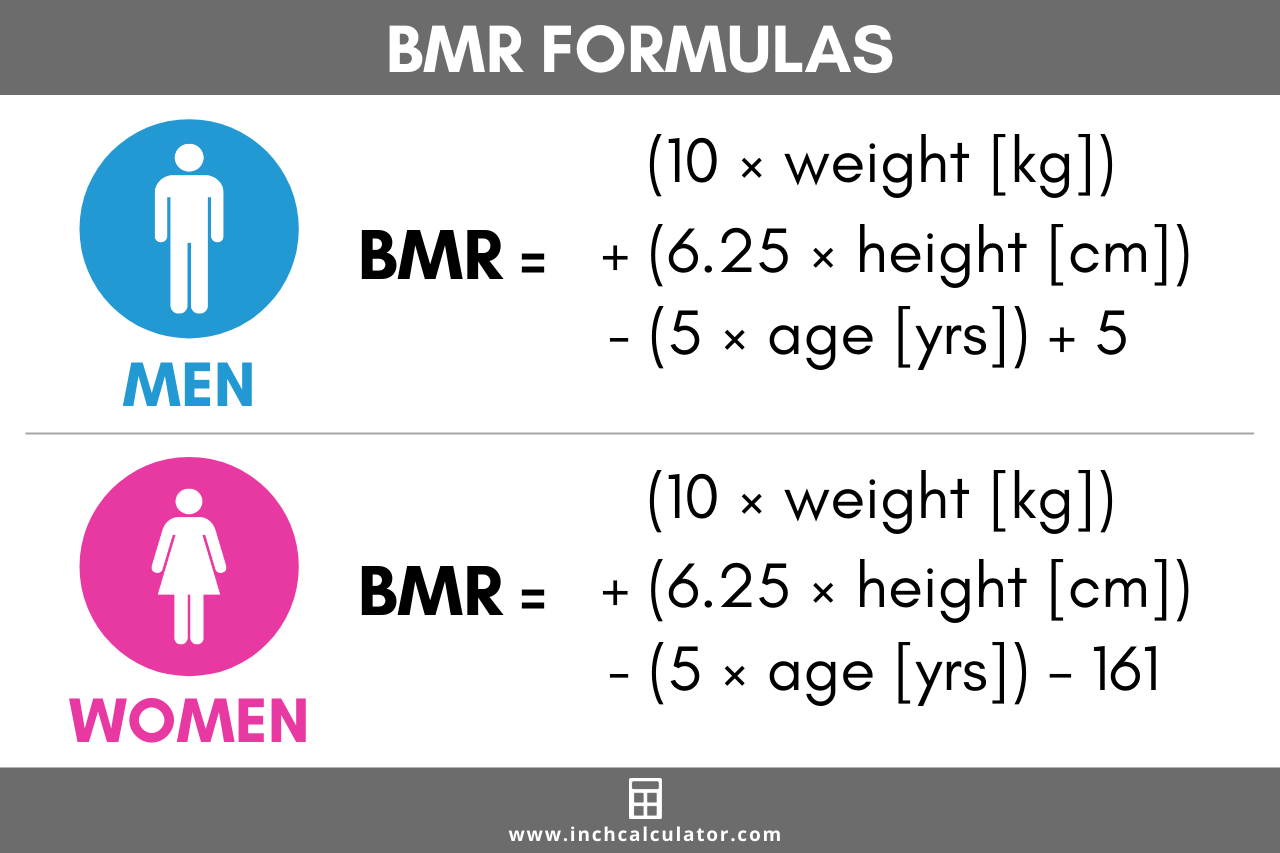BMR Calculator – Basal Metabolic Rate
Enter your age, sex, height, and weight to calculate your BMR.
Your Basal Metabolic Rate (BMR):
Your Daily Calorie Requirements
| Activity Level | Calories |
|---|---|
| little to no exercise | |
| light exercise 1-3 times per week | |
| moderate exercise 3-5 times per week | |
| heavy physical exercise 5-6 times per week | |
| heavy physical exercise 6-7 times per week |
On this page:
What is BMR?
Your basal metabolic rate (BMR) is your resting metabolism. This represents the energy, or calories, that your body requires to function when completely at rest. It includes all your normal bodily functions, such as your respiration, your heart rate, blood flow, and brain activity.
Basically, it’s all of the vital functions that keep you alive!
Everyone will have a different BMR since this is dependent on height, weight, age, and gender. The only way to determine your true BMR would be to go to a lab and have your metabolic rate measured by gas analysis through either direct or indirect calorimetry.[1]
These labs measure the heat coming off of your body to determine the number of calories that it burns at rest.
However, there are limitations to indirect calorimetry, such as cost and accessibility, that make it not possible for most people to do.[1] Since it is not possible for the majority of people to do indirect calorimetry, a number of equations have been created to try to provide the best estimate of basal metabolic rate.
How to Calculate BMR
Your BMR is based on your height, weight, age, and gender. All of these individual factors play a role in how much energy your body uses at rest.
For example, men tend to have more lean muscle mass than women, which raises their basal metabolic rate. On the other hand, older individuals generally have lower calorie needs due to decreased lean body mass and changes in hormones that play a role in metabolism.
BMR formulas
There are several different formulas that have been developed over the years to calculate BMR. These include The Mifflin-St Jeor equation, the Harris-Benedict equation, and the Katch-McArdle equation.

Harris-Benedict Equations
The original formula to calculate BMR was the Harris-Benedict equation. This formula was derived in 1919 and is still widely used today to estimate BMR.
For Men:
BMR = 66.5 + (13.75 × weight [kg]) + (5.003 × height [cm]) – (6.775 × age [years])
For Women:
BMR = 655.1 + (9.563 × weight [kg]) + (1.850 × height [cm]) – (4.676 × age [years])
The Harris-Benedict equation has gone through revisions over time to more closely approximate BMR. A reevaluation of the formula in 1984 based on new data derived the following equation:[2]
Revised Harris-Benedict Equation
For Men:
BMR = 88.362 + (13.397 × weight [kg]) + (4.799 × height [cm]) – ( 5.677 × age [years])
For Women:
BMR = 447.593 + (9.247 × weight [kg]) + (3.098 × height [cm]) – (4.330 × age [years])
It was found that this equation predicts BMR in healthy individuals with an accuracy of about +/- 14%. However, it is unreliable in those who are malnourished.
Mifflin St Jeor Equation
Due to the finding that the Harris-Benedict Equations overestimated BMR by about 5%, new predictive equations have been created. The Mifflin-St Jeor formula is now widely used and appears to provide a closer estimate of true BMR.[3]
For Men:
BMR = (10 × weight [kg]) + (6.25 × height [cm]) – (5 × age [years]) + 5
For Women:
BMR = (10 × weight [kg]) + (6.25 × height [cm]) – (5 × age [years]) – 161
Katch-McArdle Equation
Lean body mass (LBM) also plays a crucial role in basal metabolic rate.[4] Studies have found that muscle is more metabolically active than fat; therefore, your overall body composition influences how many calories you burn, even when resting.[5]
However, lean body mass is not included in many BMR equations.
The Katch-McArdle equation was developed to include lean body mass when calculating BMR to better estimate resting metabolism.[6] This involves one more step in the calculation since you need to know your lean body mass.
If you are able to measure your body fat percentage, the equation for lean body mass is:
LBM = weight[kg] × 100 – body fat % / 100
Similar to determining your BMR, the only way to know your true lean body mass would be to have your body fat percentage measured in a lab setting, with skin calipers, or with specialized machines.
Since this is not readily available to most people, you can calculate lean body mass using your weight and height with the following equations:
For Men:
LBM = 0.407 × weight [kg] + 0.267 × height [cm] – 19.2
For Women:
LBM = 0.252 × weight [kg] + 0.473 × height [cm] – 48.3
LBM is then plugged into the Katch-McArdle equation to calculate BMR.
BMR = 370 + (21.6 × lean body mass [kg])
The formulas used in the BMR calculator are the Mifflin St Jeor, Harris-Benedict equation, & Katch-McArdle equation. Each will give a slightly different value, which are all still only estimates of your basal metabolic rate.
These equations for BMR give a general idea of your body’s energy needs at rest. Of course, the rest of your activities require additional calories to fuel your day. Your job, cooking, cleaning, dressing, eating, level of additional exercise, and even your digestion all factor into the total number of calories you should eat daily.
This is known as total daily energy expenditure (TDEE) and can be determined by your average level of activity.
As you can see from these equations, there are a number of factors that play a role in your basal metabolic rate and total calorie needs. These formulas can help guide you when planning your calorie intake on a daily basis.
BMR vs. RMR
Resting metabolic rate (RMR) and basal metabolic rate are often used interchangeably to define the energy used by the body at rest, but they are a bit different.
Basal metabolic rate is the minimum amount of energy needed during complete physical, mental, and digestive rest.[7]
Resting metabolic rate, also known as resting energy expenditure (REE), is the rate of energy expended, or burned, while at rest.[7] It includes the energy expended for bodily functions such as sweating or eating food.[8]
So, the difference is subtle, and in fact, both BMR and RMR use the same equations above.
Similar Nutrition Calculators
References
- Delsoglio, M., Achamrah, N., Berger, M. M., & Pichard, C., Indirect Calorimetry in Clinical Practice, Journal of clinical medicine, 2019, 8(9), 1387. https://doi.org/10.3390/jcm8091387
- Roza, A. M., & Shizgal, H. M., The Harris Benedict equation reevaluated: resting energy requirements and the body cell mass, The American journal of clinical nutrition, 1984, 40(1), 168-182. https://doi.org/10.1093/ajcn/40.1.168
- Mifflin, M. D., St Jeor, S. T., Hill, L. A., Scott, B. J., Daugherty, S. A., & Koh, Y. O., A new predictive equation for resting energy expenditure in healthy individuals, The American journal of clinical nutrition, 1990, 51(2), 241-247. https://pubmed.ncbi.nlm.nih.gov/2305711/
- Cunningham, J. J., A reanalysis of the factors influencing basal metabolic rate in normal adults, The American journal of clinical nutrition, 1980, 33(11), 2372-2374. https://pubmed.ncbi.nlm.nih.gov/7435418/
- Zurlo, F., Larson, K., Bogardus, C., & Ravussin, E., Skeletal muscle metabolism is a major determinant of resting energy expenditure, The Journal of clinical investigation, 1990, 86(5), 1423-1427. https://www.jci.org/articles/view/114857
- Katch, F. I., & McArdle, W. D., Validity of body composition prediction equations for college men and women, The American journal of clinical nutrition, 1975, 28(2), 105-109. https://pubmed.ncbi.nlm.nih.gov/1115020/
- Pethusamy, K., Gupta, A., & Yadav, R., Basal Metabolic Rate (BMR), Encyclopedia of Animal Cognition and Behavior, 2019, 1–3, https://doi.org/10.1007/978-3-319-47829-6_1429-1
- WebMD, Differences Between BMR and RMR, https://www.webmd.com/fitness-exercise/difference-between-bmr-and-rmr



